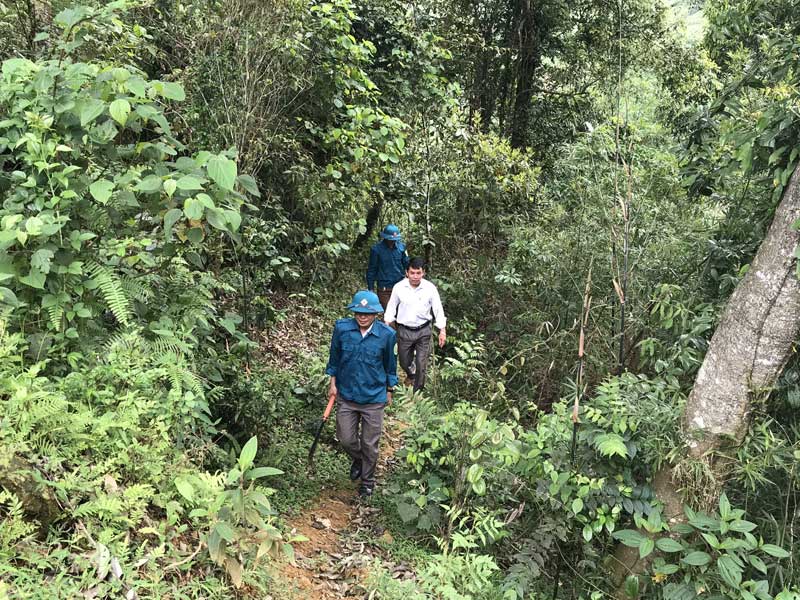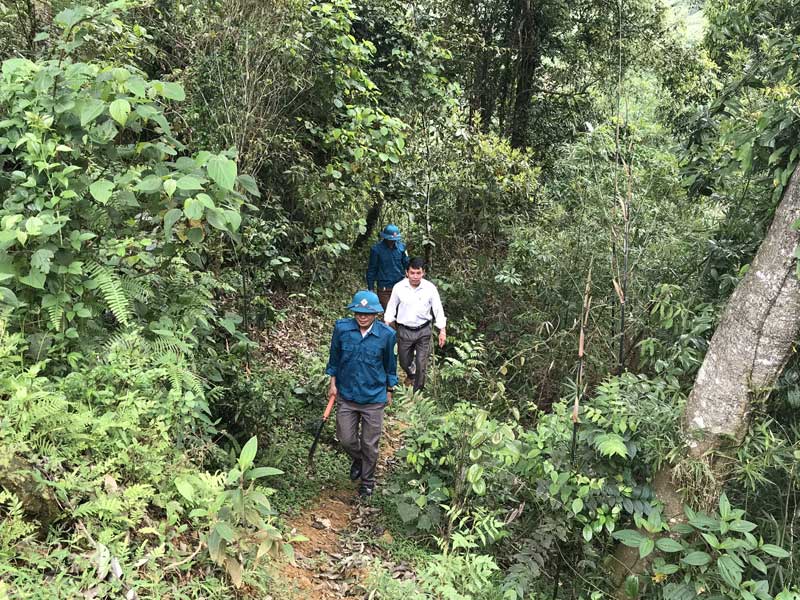
(HBO) - Eight km far from the center of the district, there is 3,500 ha of forest in Thanh Son commune, of which, 70% of the area is the protection forests, assigned to 11 hamlets for management and protection.
 The forest protection group of Noong
Luong village, Thanh Son commune (Mai Chau) regularly goes on patrol to
promptly detect the illegal forest encroachment activities.
The forest protection group of Noong
Luong village, Thanh Son commune (Mai Chau) regularly goes on patrol to
promptly detect the illegal forest encroachment activities.
The area of protection forests is large with many perennial and rare timber trees, holding the headwaters position in regulating water sources at the same time. Therefore, the Party Committee and the authority of the commune always pay attention and direct the People to perform well the forest protection.
Currently,
there are 22 forest protection teams with from 3-5 people each in the whole
commune. They include the village heads, police officers, militia. They go on
patrols at a frequency of 1-2 times every month to timely detect and handle the
acts of deforestation and forest encroachment. At the village meetings, the
heads of hamlets, the secretaries of the Party cell and the reputable people
regularly propagate and sign the commitments with the local people, putting
into the residential conventions and regulations on the forest protection.
Every year, the units contracted for management and forest protection in the
commune receive the supported money in accordance with the policy of payment
for forest environmental services. As a result, the local people are more aware
of the forest protection. In the peak months of the hot season, the forest fire
prevention and fighting are strictly implemented, organizing the clearing of
plants and vegetation, guiding the people to burn up with the correct techniques,
promptly grasping the situation and ensuring the response to the possible
situation.
Up
to now, the forest coverage of the whole commune has reached 63%. The
orientation of forest management and protection associated with economic
development, especially the service of the community tourism, the commune has
been mobilizing the local people to actively participate in improving and
planting forests, protecting the environmental landscapes and assisting the
different types of tourism services and the socio-economic development.
Currently, in the whole commune there are 2 homestays with many types of
services, eco-tourism, which has been highly appreciated by visitors, and have
gone on operation effectively. Besides, the commune is implementing the planning
and the construction of the tourism area of Sam Tang lake with the beautiful
mountains and forests and the total area of 80 hectares. It is expected that
the tourism area will have many interesting services such as lakeside resort,
the health care with herbs, creating jobs for many local workers.
A diverse chain of eco-tourism and resort destinations concentrated in Hoa Binh city and the districts of Tan Lac, Da Bac, and Luong Son… Along with the launch of several key high-quality resort tourism projects, these developments have reshaped the landscape and enhanced the appeal of Hoa Binh as a travel destination.
Boasting diverse terrain, a mild climate, and rich natural resources, Cao Phong district is increasingly asserting its place on Vietnam’s tourism map, attracting both domestic and foreign visitors. The district is renowned for its stunning landscapes, majestic mountains, a crystal-clear hydropower lake, and the unique cultural identity of local ethnic groups.
With its pristine landscapes, unique cultural heritage of Muong ethnic minority, and an expanding range of visitor experiences, Tan Lac district of Hoa Binh has fast become a captivating destination for both domestic and international tourists.
Until now, Sung village in Cao Son commune, Da Bac district remains the only Dao ethnic community in Hoa Binh province to develop a community-based tourism model. Beyond its untouched natural landscapes, cultural identity serves as the cornerstone attraction for visitors.
Alongside the diverse cultural identities of the Kinh, Muong, Tay, Thai, Dao, and Mong ethnic people, Hoa Binh province is also renowned as the "capital" of the northwestern Vietnamese cuisine, offering unique and distinctive dishes. At festivals, during Lunar New Year (Tet), or on significant family or community occasions, special dishes are prepared, leaving a lasting impression on visitors.
A Phong Linh (Yellow Tabebuia) flower garden in Thang village, Thach Yen commune, Cao Phong district is currently in full bloom, drawing a large number of visitors.



 The forest protection group of Noong
Luong village, Thanh Son commune (Mai Chau) regularly goes on patrol to
promptly detect the illegal forest encroachment activities.
The forest protection group of Noong
Luong village, Thanh Son commune (Mai Chau) regularly goes on patrol to
promptly detect the illegal forest encroachment activities.